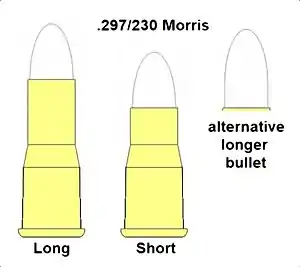.297/230 Morris
The .297/230 Morris Short and .297/230 Morris Long are two obsolete centerfire firearm cartridges developed as sub-caliber training rounds for the British Martini–Henry rifle.
| .297/230 Morris Short | ||||||||
|---|---|---|---|---|---|---|---|---|
 | ||||||||
| Type | Rifle & pistol | |||||||
| Place of origin | United Kingdom | |||||||
| Specifications | ||||||||
| Case type | Rimmed, bottleneck | |||||||
| Bullet diameter | .225 in (5.7 mm) | |||||||
| Neck diameter | .240 in (6.1 mm) | |||||||
| Shoulder diameter | .274 in (7.0 mm) | |||||||
| Base diameter | .294 in (7.5 mm) | |||||||
| Rim diameter | .347 in (8.8 mm) | |||||||
| Case length | .58 in (15 mm) | |||||||
| Overall length | .89 in (23 mm) | |||||||
| Primer type | Kynoch # 69 | |||||||
| Ballistic performance | ||||||||
| ||||||||
| Source(s): Cartridges of the World.[1] | ||||||||
| .297/230 Morris Long | ||||||||
|---|---|---|---|---|---|---|---|---|
 | ||||||||
| Type | Rifle | |||||||
| Specifications | ||||||||
| Case type | Rimmed, bottleneck | |||||||
| Bullet diameter | .225 in (5.7 mm) | |||||||
| Neck diameter | .240 in (6.1 mm) | |||||||
| Shoulder diameter | .274 in (7.0 mm) | |||||||
| Base diameter | .295 in (7.5 mm) | |||||||
| Rim diameter | .345 in (8.8 mm) | |||||||
| Case length | .80 in (20 mm) | |||||||
| Overall length | 1.1 in (28 mm) | |||||||
| Primer type | Kynoch # 69 | |||||||
| Ballistic performance | ||||||||
| ||||||||
| Source(s): Cartridges of the World.[1] | ||||||||
Design
The .297/230 Morris Short and .297/230 Morris Long are both rimmed bottlenecked centrefire miniature rifle and pistol cartridges.[1]
.297/230 Morris Short
The .297/230 Morris Short fired a 37 gr (2.4 g) lead projectile driven by 3.25 gr (0.211 g) of black powder at 875 ft/s (267 m/s).[1][2]
.297/230 Morris Long
The .297/230 Morris Long fired a 37 gr lead projectile driven by 5.5 gr (0.36 g) of black powder at 1,200 ft/s (370 m/s).[1]

History
The .297/230 Morris cartridges were produced for use in the Morris Aiming Tube, a commercial sub-calibre barrel inserted into the barrel of a large bore rifle or pistol for training or short range target practice. The Morris Aiming Tube worked well enough for it to be adopted for service in August 1883 by both the British Army and the Royal Navy for use in the Martini-Henry rifle.[1][2][3]
The Morris Aiming Tube was later adapted for use in the .303 British Martini-Metford rifle, the Lee–Metford rifle in 1891 and the Webley Revolver, with both the .297/230 Morris Short and the .297/230 Morris Long being fired through the tubes. In the Lee-Metford rifle, the Morris Tube and the .297/230 cartridge were not particularly accurate and were replaced after 1908 by a new .22 in (5.6 mm) tube firing the rimfire .22 Long Rifle cartridge which was more accurate, quieter and much cheaper.[1][2][4][5][6]
Birmingham Small Arms Company produced Martini actioned rook rifles chambered in these cartridges, and some European single shot pistols and rifles were also chambered in them. The cartridges were still manufactured by Eley Brothers and Kynoch as late as 1962.[1]
In the 1890s Holland & Holland developed the .297/250 Rook cartridge by blowing out the neck of the .297/230 Morris Long cartridge to .250 in (6.4 mm).[7]

References
- Frank C. Barnes, Cartridges of the World, 15th ed, Gun Digest Books, Iola, 2016, ISBN 978-1-4402-4642-5.
- Tony Edwards, ".23 inch Aiming Tube", sites.google.com/site/britmilammo, retrieved 4 April 2018.
- Imperial War Museums, "5.7 X 15R; .297/.230 Short & .230 Morris Short", iwm.org.uk, retrieved 4 April 2018.
- Historic arms resource centre, "The aiming tubes - Morris .297/.230 centrefire calibre and .22 rimfire", rifleman.org.uk, retrieved 5 April 2018.
- Imperial War Museums, "5.7 X 20R; .297/.230 Morris Long", iwm.org.uk, retrieved 4 April 2018.
- John Walters, Rifles of the World, Krause Publications, Iola, 2006, ISBN 978-0-89689-241-5.
- Imperial War Museums, "6.35 x 20.5R: Kynoch; .297/.250 Rook Rifle", iwm.org.uk, retrieved 22 April 2017.
External links
- The Morris Aiming Tubes
- Ammo-One, ".297/230 Morris Short", ammo-one.com, retrieved 4 April 2018.
- Cartridgecollector, "297/230 Morris Long", cartridgecollector.net, retrieved 4 April 2018.
- Cartridgecollector, "297/230 Morris Short", cartridgecollector.net, retrieved 4 April 2018.
- The Spanish Association of Cartridge Collectors, ".297-.230 Morris Long", municion.org Archived 5 April 2018 at the Wayback Machine, retrieved 4 April 2018.
- The Spanish Association of Cartridge Collectors, ".297-.230 Morris Short Mk I", municion.org Archived 5 April 2018 at the Wayback Machine, retrieved 4 April 2018.